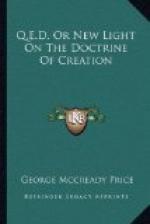And the bearing of these facts on the other problem of the transmission of acquired characters is quite obvious. Mendelism provides no place for any such transmission. Mendel’s Law is sometimes called the law of alternative inheritance, thus embodying in its name the thought that offspring may show the characters possessed by one parent or by the other, but that it cannot develop any characters whatever which were not manifest or latent in the ancestry. Changes in the environment during the embryonic stage, it is true, seem sometimes to be registered in the growing form; but it has never yet been proved that these induced changes can ever amount to a unit character or genetic factor that will maintain itself and segregate as a distinct factor after hybridization. Ancestry alone furnishes the material for the factor, and no amount of induced change can get itself registered in the organism so as to come into this charmed circle of ancestral characters which alone seem to be passed on to posterity.
A quotation from Bateson ought to set this point at rest:
“The essence of the Mendelian principle is very easily expressed. It is, first, that in great measure the properties of organisms are due to the presence of distinct, detachable elements [factors], separately transmitted in heredity; and secondly, that the parent cannot pass on to offspring an element, and consequently the corresponding property, which it does not itself possess."[28]
[Footnote 28: Scientific American Sup., January 3, 1914.]
Heredity we now see is a method of analysis, and the facts brought to light by Mendelism help us very much toward an understanding of living matter. Especially does it help us to understand the complexity underlying the facts of heredity, which until now have seemed so strange and capricious. As Professor Punnett of Cambridge remarks:
“Constitutional differences of a radical nature may be concealed beneath an apparent identity of external form. Purple sweet peas from the same pod, indistinguishable in appearance and of identical ancestry, may yet be fundamentally different in their constitution. From one may come purples, reds, and whites; from another only purples and reds; from another purples and whites alone; whilst a fourth will breed true to purple. Any method of investigation which fails to take account of the radical differences of constitution which may underlie external similarity, must necessarily be doomed to failure. Conversely, we realize to-day that individuals identical in constitution may yet have an entirely different ancestral history. From the cross between two fowls with rose and pea combs, each of irreproachable pedigree for generations, come single combs in the second generation, and these singles are precisely similar in their behavior to singles bred from strains of unblemished ancestry. In the ancestry of the one is to be found no single over a long series of years; in the ancestry of the other nothing but singles occurred. The creature of given constitution may often be built up in many ways, but once formed it will behave like others of the same constitution."[29]




